Author: Amanda Lillie
4. Mysterious ruins: the nostalgia of receding time
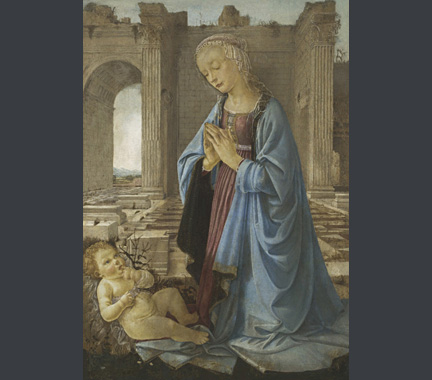
The ‘Virgin Adoring the Infant Christ’ [link to entry] attributed to Verrocchio and once owned by John Ruskin is close in date to Botticelli’s tondo, and was probably painted in the early 1470s (fig. 21). It is a study in nostalgia. This emotion is evoked through the pose and attitude of the Madonna, but it also lies in the architecture and its relationship to the figures, in the forms of the buildings, their ruined state and the ways in which they are depicted.
The architectural setting before which the Madonna and Child are placed is highly distinctive and unusual. The Virgin Mary kneeling on the ground to adore the Christ Child was often depicted in front of the stable (as in Ercole de’ Roberti’s, ‘The Adoration of the Shepherds’) or in woodland or landscape, and the magnificent architecture – even in a ruined state – does not seem to be consistent with the message of humility. We are presented with screen architecture which mostly hides what lies behind it, and only reveals a segment of its whole structure so that it is difficult to imagine it as a habitable building. As well as its incomplete state, the way in which Verrocchio lets the building continue beyond the frame to the left and right denies the viewer key information, as we will never know how the ruin starts or ends. Whereas Botticelli presents a partial skeleton of a whole building that was largely transparent and altogether airy, Verrocchio focuses on walls creating a rectangular bay or niche, and on a single archway the depth of which emphasises the solidity and thickness of the adjoining wall. Its beauty partly lies in the artist’s appreciation of wall architecture, its mass and height, its surfaces, its potential to shut off or enclose, and to affect light and shadow even when outdoors.
A fragment of wall or temple?
Just as our view of Verrocchio’s ruin is more restricted, so is its original purpose more difficult to fathom than Botticelli’s. Whereas most buildings in Italian Renaissance paintings declare their function by conforming to type, this could be a piece of city wall or a fragment of a temple. The arch would seem to offer a clue. It does not look like a Roman triumphal arch, for despite the depth and mass of the archway and the fine stone coffering of its barrel vault, it lacks the sculptural additions and is set back from the side wall, giving it too little prominence. It is closer to the Porta di San Pietro in Perugia, a city gate designed by Agostino di Duccio, which is flanked by projecting rectangular bays with Corinthian pilasters (fig 22).35
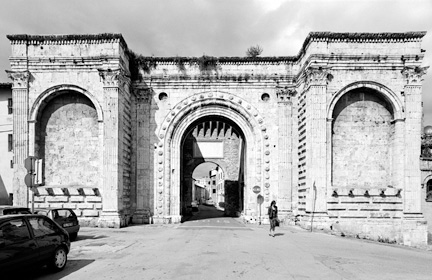
Yet in Verrocchio’s painting the line of bases intended to carry rectangular piers receding either side of the Virgin, together with the grand Corinthian pilasters, strongly suggest this was some type of temple. If it is a temple or church, the bases of the piers are too closely spaced for this to be a view across the nave towards a side chapel, nor does it make sense as a view down a nave since it is too short and ends in a blank wall. Again our information is insufficient and apparently contradictory.
Nor is there a sense of locality. This is an abstract liminal place between a series of thresholds: a narrow strip of meadow, a pavement edge, an open arch, a wall. They all seem to promise something, or be on the verge of leading somewhere we can never reach. The architecture remains typologically ambivalent, truncated, out of place and puzzling as a ruin should be.
Although its authoritative classical forms, tall pilasters, thick walls, and deep arch lend the architecture presence and magnificence, it also conveys vulnerability, not only because it is clearly a ruined fragment, but also because the extraordinarily fine rendering of surfaces and detail makes it look delicate and prone to decay (fig. 23). This effect is created by very precise and beautiful drawing and incision executed with amazing sensitivity, in places so delicately that the lines appear intermittent.
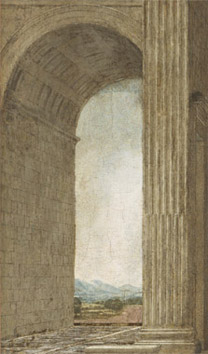
The way the draughtsmanship can be read throughout the painting, in lines perceptible through the painted forms, is probably partly the result of invasive cleaning (long before the painting was purchased by the Scottish National Gallery) and the fact that the picture has been twice relined, but it acts on the viewer like a metaphor for a ruin. The technique itself – the preparatory drawing behind the painting – creates a structure which is partly seen and partly imagined, revealing its essential self through its incomplete state.
The weeds are a crucial feature (fig. 24). They are scattered over the whole surface of the picture: along the crevices of the pavement so that they seem to form their own geometric grid diminishing into the distance, drooping from the ledges of cornices, and standing out along the tops of the walls where their ragged, irregular stalks, grasses and leaves break up the architectural lines, adding to the air of decay and expressing the random damage caused by time. The weeds mark and measure time.
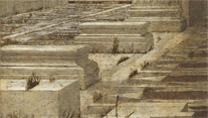
As the ultimate product of random, wild, small-scale, natural growth they will eventually win out over purposefully designed, large-scale, man-made, architectural splendour. Significantly, the Christ Child is born not on the architectural pavement, but among the weeds.
The theme of recession could be said to permeate the painting through the geometric pavement, which sets up the perspectival scheme for the whole picture. The paving rapidly diminishes towards the back wall of the ruin and on through the arch towards the distant river valley. The rest of the architecture is constructed within this scheme, the pier bases, the foreshortened side walls, and the coffers in the vault of the arch all receding in unison. The single block or cornerstone isolated from the piers and walls at the front edge of the pavement is positioned as though it were the left base of a portal that would extend up and around the Virgin Mary (fig. 25).
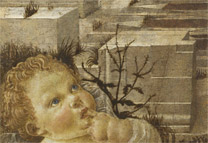
It no doubt alludes to Christ as the cornerstone mentioned in the Bible.36 But this block also provides a microcosmic display of recession achieved by architectural stone carving, and its brilliant simulation in pictorial form. Each layer of the block is cut slightly further back from the one before, receding infinitesimally, but measurably, since the drawing is crisp and the white highlights define each step back. This is like a painter’s version of an architect’s template, but shown frontally rather than in profile. The cornerstone is brought to the front and slightly realigned so we can note its religious significance and observe it as a portal to the ruin and an introduction to receding time and space.
This virtuoso perspectival display employed to depict antiquity in ruins is conjoined with the contemplative prayer of the Virgin. The perspective performs a visual pun, as antiquity literally recedes away from the Virgin and Child who are placed outside receding time on the strip of meadow in the foreground. If the Virgin is sad (if that is the right word) it would not be for lost antiquity but for the Crucifixion already sensed in the future. Yet the air of nostalgia, a consciousness of our distance from the ancient world, and of our inability to entirely recapture or relive it, lingers in the picture.
Read further sections in this essay
- 1. Introduction
- 2. The stable of the Nativity: holy rusticity and primitive time
- 4. The ruined temple: architecture subject to time
To cite this essay we suggest using
Amanda Lillie, 'Architectural Time' published online 2014, in 'Building the Picture: Architecture in Italian Renaissance Painting', The National Gallery, London, http://www.nationalgallery.org.uk/research/research-resources/exhibition-catalogues/building-the-picture/architectural-time/mysterious-ruins
